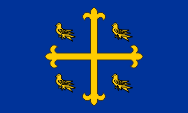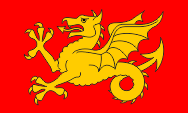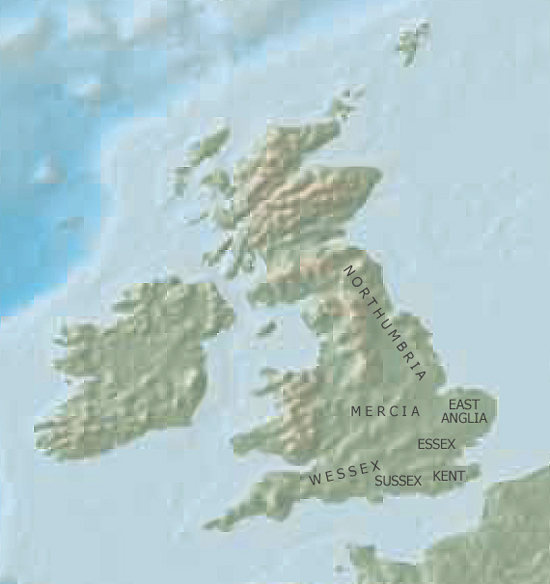mobile View, to the German Version tap the flag


- "Western Saxony"
- former Kingdom in Southern England
- own name: Westseaxna rīce
• Introduction
• History
• Flag
• Meaning/Origin of the Flag
• Map
Britannia was conquered by Roman legions around the year 43 and became in 85 a province of the Roman Empire. Towards the end of the fourth century the Roman Empire came under considerable pressure from outside, so that Britannia could no longer be held. Thus the Romans began to withdraw about 400 or 410. Shortly afterwards, Jutes and Angles began to migrate in eastern and southern Britannia coming from today's Denmark and Saxons coming from the area of the Weser and Elbe estuaries, and also some Frisians. The differences between the peoples blurred over the generations, and they were summarized under the term Anglo-Saxons. As fighters they have been very welcome for the mostly Romanesque Celtic British, against the since the withdraw of the Romans advancing Picts and Scots. Already in the middle of the fifth century, they had established themselves as the new aristocracy and began to separate from themselves by the formation of their own kingdoms.
Since the beginning of the 6th century, seven great kings have been known which dominated the south and east of Britannia. A formation of states that has become known in history as "Heptarchy" (Greek: hepta = seven). These have been the kingdoms of Sussex, Wessex, Essex, Kent, East Anglia, Mercia and Northumbria. However, in reality, there have been more and some smaller kingdoms, which, however, often existed for only a short time. In 825 Wessex, Sussex, Kent and Mercia became united under King Egbert of Wessex. Essex, East Anglia and parts of Mercia were occupied by invading Danes in the year 865 and became summarized as "Danelaw" (Danelag, territory of Danish law). In 1016 the Danish Knut the Great (brother of the king of Denmark) forced his election to the first king of England. After riots the Danish rule ended in 1050, and in 1066 Harald II., Earl of Wessex, was crowned to the first Anglo-Saxon King of England.
Source: Wikipedia (D)

The Kingdom of Wessex was first mentioned in 519. It is a foundation of the Saxons, and was placed in the west of the area, which was inhabited by the Saxons in Britain. The name implies "Western Saxony". At the end of the 7th century were temporarily conquered the kingdoms of Sussex and Kent and the Isle of Wight. At the beginning of the 8th century, the kingdoms of Sussex and Kent were conquered again, and in addition the kingdoms of Essex and Mercia and also large parts of Celtic Dumnonia. Mercia could regain its independence 830. From 871 to 878 Wessex was occupied by the Danes. In 917 the eastern Midlands and East Anglia were conquered in fights against the Danes and in 918 the king of Wessex became the ruler of Mercia. It follows the conquest of Northumbria in 927, and from 931, the King of Wessex was called "King of Britain".
Source: Wikipedia (D)


Flag of Wessex,
ratio = 3:5,
Source, by: Wikipedia (D)




Flag of Wessex, designed by William Crampton
ratio = 3:5,
Source, by: Wikipedia (EN)






The time of the Heptarchy belongs – in the themes of flags or coats of arms – to the period of protoheraldics. This means that seals, coats of arms or flags, as we know them today, were not yet in use. Nevertheless, it seems that there was a kind of symbolism, which is partly handed down, or it is known from the field of legends. The coats of arms or flags were designed in the modern age, which are used now for the ancient kingdoms of the Heptarchy.
The today well-known Heraldry of Wessex was created in modern times. The red flag with the golden Dragon (also called "wyvern") was created in the 1970's by William Crampton. The symbolism goes back to a legend from the 8th century, in which the West Saxons had shown such a dragon in the battle of Burford in A.D. 752. Also the of Bayeux Tapestry shows such a Dragon, however there is no evidence that the Dragon is actually connected with Wessex. A coat of arms that is handed down from the 13th century, is the coat of arms of King Edward the confessor of the House of Wessex, from which it is assumed that it actually presents the symbolism of Wessex. It shows a golden anchor cross between four martlets ("blackbirds") on a blue background. A martlet is a duck-like bird, which is often mutilated, so that the beak and feet are missing.
Source: Wikipedia (EN), Volker Preuß


Source: Freeware, University of Texas Libraries, modyfied by: Volker Preuß


![]()









